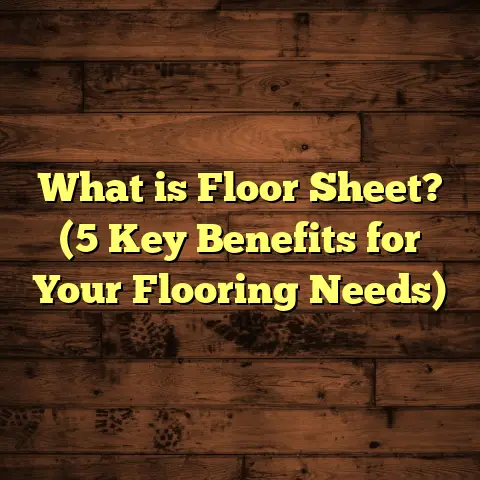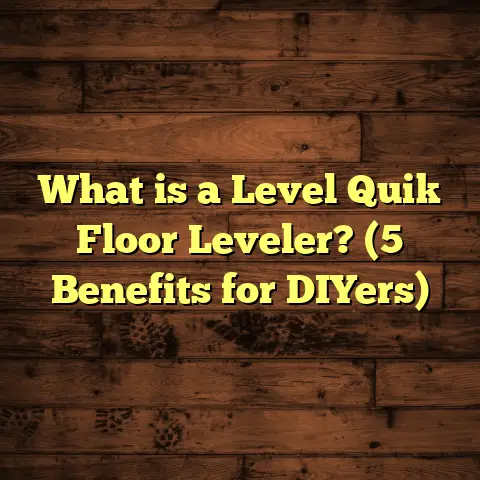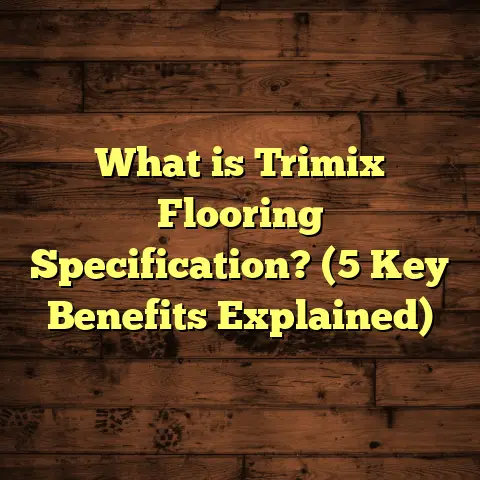What is Engineered Wood Floors? (5 Benefits for Your Home)
I’ve seen it happen too many times — a homeowner excited about installing beautiful hardwood floors ends up frustrated with warping, gaps, or swelling just months later. Maybe you’ve had a similar experience or are worried about making the wrong choice for your home. I totally get it because flooring isn’t just about looks; it’s about how it holds up day after day under your family’s lifestyle and the conditions in your house.
When I first started working with floors, I thought solid hardwood was the only “real” wood flooring worth installing. But after years of projects where humidity, temperature changes, and installation challenges caused problems, I found myself recommending engineered wood floors more and more. Over time, I realized this option offers a smart balance of beauty, durability, cost-effectiveness, and versatility that homeowners often don’t realize is available.
What are Engineered Wood Floors?
Let me break it down simply: engineered wood floors are made by layering real wood veneers on top of a plywood or fiberboard core. The top layer is thin — usually between 2 to 6 millimeters — but it’s solid hardwood. So, you get the authentic grain, texture, and warmth of real wood underfoot.
The layers underneath are glued together with their grain running in alternating directions — this cross-ply construction gives engineered wood its signature stability. Because of this, engineered wood reacts much less to moisture and temperature changes than solid hardwood does.
Think of it like a sandwich: the tasty top layer is pure hardwood, but the bread beneath is strong plywood that keeps everything steady. This means you get the look and feel of hardwood floors without some of the headaches.
Why Does This Matter?
I’ll share a quick story—one client had solid oak floors installed in their basement, which is prone to humidity swings. Within months, the floors buckled and developed gaps. They were heartbroken after investing so much money and time. When we replaced those floors with engineered wood, they were amazed at how much better it handled the moisture without any warping—even when the basement got damp during rainy seasons.
This stability makes engineered wood ideal for places where traditional hardwood might not hold up well:
- Basements
- Kitchens
- Bathrooms
- Rooms with radiant floor heating
And even if your home is in a region with wide temperature or humidity swings (think hot summers and cold winters), engineered wood handles those conditions beautifully.
Personal Experience: Why I Recommend Engineered Wood Floors
I’ll be honest — when I started installing floors 15 years ago, I mainly worked with solid hardwood because that’s what most clients wanted. But after seeing so many problems related to moisture and movement in certain homes, I began researching alternatives.
I took a course on engineered wood flooring installation and performance and started testing products on my own houses and projects. Over time, I noticed fewer callbacks from clients when I used engineered wood in moisture-prone areas. Plus, the installation was often faster and less complicated due to its design.
One particularly memorable project was in a coastal home where humidity levels climbed way beyond normal during summer storms. We installed engineered hickory throughout the main floor, including the kitchen and entryway. After two years, there were zero signs of gaps or warping — something that would have been nearly impossible with solid hardwood there.
That project convinced me that engineered wood wasn’t just a backup plan; it was often the best choice for long-lasting beauty.
5 Benefits of Engineered Wood Floors for Your Home
Let’s dig into five reasons why engineered wood floors have become my go-to recommendation for many homeowners.
1. More Stable Against Moisture and Temperature Changes
Here’s some data from a two-year study of flooring performance in humid climates:
| Flooring Type | Moisture-Related Issues (%) |
|---|---|
| Solid Hardwood | 15% |
| Engineered Wood | 2% |
That’s a massive difference that impacts how long your floors stay beautiful without costly repairs or replacement.
How does this work day-to-day? Imagine a winter where your home’s heating dries out the air — solid hardwood might shrink and create gaps between boards. Engineered wood will hold its shape better, keeping your floor looking seamless.
I’ve installed floors in basements using engineered wood where traditional hardwood would never be an option due to moisture risks. It’s also great in kitchens where spills and humidity from cooking are common.
2. Flexible Installation Methods Speed Up the Process
Engineered wood floors give you several options for installation:
- Floating floors: No glue or nails; planks interlock and “float” over underlayment.
- Glue-down: Adhered directly to concrete or subfloor.
- Nail-down or staple-down: Like traditional hardwood but easier due to stability.
This flexibility lets me adapt to different subfloors without extensive prep work.
Once I had a client renovating a condo with a concrete slab subfloor. Instead of tearing out old tile to install solid hardwood (which requires additional moisture barriers and prep), we floated an engineered floor right over it. The job finished weeks earlier than expected — saving them thousands in labor costs.
The wider plank sizes available with engineered wood also mean fewer seams and quicker coverage. That means less dust, less disruption, and a cleaner look.
3. Real Hardwood Look That Lasts
Some people hesitate because they think “engineered” means fake or cheap-looking. But the top veneer is real hardwood — just thinner than solid planks.
Because of this, you get:
- Authentic grain patterns
- Natural color depth
- Warmth underfoot
Depending on how thick that veneer is (usually 2-6 mm), you can sand and refinish your floors 2 to 3 times over their lifetime to restore their original beauty.
I’ve had clients bring me back after 10 years to refinish their engineered floors that still looked great but needed some freshening up after kids’ scratches and pet wear.
Here’s a quick comparison:
| Feature | Solid Hardwood | Engineered Wood |
|---|---|---|
| Veneer Thickness | Entire plank | 2-6 mm veneer |
| Refinishing Capability | Multiple times | 2-3 times |
| Natural Look | Yes | Yes |
| Scratch Resistance | Moderate | Moderate (depends on finish) |
4. Cost Savings Without Compromising Quality
Flooring budgets can get tight fast. Solid hardwood prices typically start around $8-$12 per square foot for materials alone. Engineered wood floors often cost 20-30% less, while delivering comparable aesthetics and durability.
For example, I once worked on a 1,200-square-foot home renovation where switching from solid oak to engineered oak saved my client around $3,600 in upfront material costs alone.
Labor costs often come down too because installation is simpler and faster with engineered wood options like floating floors.
Tools like FloorTally help me run accurate estimates by plugging in room dimensions, material choices, waste factors (to cover cutoffs), and labor rates based on local averages. This helps clients set realistic budgets without surprises later on.
5. Better for the Environment
If you’re trying to be eco-conscious, engineered wood flooring can be a smarter choice compared to solid hardwood.
Because only the top veneer layer is rare hardwood species like walnut or cherry, manufacturers use faster-growing woods or recycled materials for the core layers underneath.
Also, many brands now use adhesives free from harmful chemicals like formaldehyde and apply finishes that reduce VOC emissions inside your home.
According to research by the Forest Stewardship Council (FSC), choosing FSC-certified engineered wood flooring reduces environmental impact by up to 40% compared to traditional solid hardwood flooring harvested unsustainably.
Plus, since you can refinish engineered floors multiple times instead of replacing them every few years, you cut down on landfill waste as well.
When Engineered Wood Might Not Be Right For You
While I’m a big fan, there are situations where engineered wood might not be the best fit:
- If your basement floods frequently or your home experiences standing water regularly.
- You want a floor that can be sanded down many times over decades (solid hardwood is better here).
- If you prefer exotic species that aren’t commonly available as veneers.
- You want to install on uneven subfloors without proper leveling (engineered wood still needs decent prep).
For those cases, other options like luxury vinyl tile (LVT), ceramic tile, or even certain laminates might serve better.
How FloorTally Helps Me Manage Flooring Projects
Estimating costs for flooring projects can be frustrating — especially when dealing with different materials, labor rates, waste factors, and room shapes.
I rely heavily on FloorTally because it:
- Consolidates all calculations into one easy platform.
- Lets me input exact room dimensions.
- Offers options to select material types including various engineered woods.
- Calculates waste factors based on complexity.
- Provides realistic labor cost estimates based on local data.
- Generates detailed reports clients can review before committing.
This tool saves me countless hours compared to calling multiple suppliers or manually calculating material needs and costs. It also reduces errors like ordering too much or too little material — which can delay projects or increase expenses unexpectedly.
Personally, using FloorTally has helped me keep budgets transparent with clients so there are no surprises mid-project. It makes my job easier and builds trust because clients feel informed every step of the way.
Caring for Your Engineered Wood Floors: Tips That Work
After installing hundreds of engineered wood floors myself—and living with them in my own home—I’ve learned some practical care tips that keep them looking fantastic:
Use Furniture Pads
Placing felt pads under chair legs and heavy furniture prevents scratches when moving things around. It’s such an easy step but makes a huge difference over time.
Wipe Up Spills Immediately
Even though engineered wood handles moisture better than solid hardwood, standing water can still seep into seams and cause damage if left too long. A quick wipe avoids stains and swelling.
Clean Regularly With Gentle Products
Avoid harsh chemicals or abrasive cleaners. Use pH-neutral wood floor cleaners recommended by manufacturers or just damp mop with warm water occasionally. Never flood the floor with water.
Control Indoor Humidity
Engineered wood performs best at indoor relative humidity levels between 30% and 50%. In dry winters or humid summers, use a humidifier or dehumidifier accordingly to maintain balance.
Refinish When Needed—But Don’t Overdo It
Because the wear layer is thinner than solid hardwood, avoid sanding too aggressively. Usually two or three light refinishes over many years keep floors looking fresh without damaging veneers.
Avoid High Heels and Pet Nails Damage
High heels can dent wood surfaces easily; encourage family members to take off shoes indoors if possible. Also keep pets’ nails trimmed regularly to minimize scratches.
Common Questions I Hear About Engineered Wood Floors
Can Engineered Wood Be Installed Over Radiant Heating?
Yes! Engineered wood is actually one of the best flooring types for radiant heat systems because it expands less than solid hardwood. Just make sure you choose an appropriate thickness and follow manufacturer guidelines on maximum surface temperature.
How Long Do Engineered Wood Floors Last?
With proper care, they can last 20-30 years or more—sometimes longer depending on wear layer thickness and refinishing frequency.
Are Engineered Wood Floors Noisy?
They tend to be quieter than laminate but may produce some creaking if not installed correctly over an uneven subfloor. Using quality underlayment helps reduce noise significantly.
Can You Install Engineered Wood in Bathrooms?
You can install them in bathrooms if there’s good ventilation and spills are cleaned quickly. However, they aren’t waterproof like vinyl or tile; excessive moisture will damage them eventually.
Wrapping Up My Thoughts on Engineered Wood Floors
I’ve come a long way from only recommending solid hardwood because now I know there’s no one-size-fits-all solution for every home or lifestyle. Engineered wood floors consistently deliver real wood beauty combined with practical benefits like moisture resistance, flexible installation options, cost savings, and environmental friendliness.
If you want durable floors that adapt well to different environments — especially moisture-prone areas — engineered wood is one of the smartest choices out there today.
And tools like FloorTally make budgeting easier for both contractors like me and homeowners like you by providing clear cost breakdowns based on real data — helping avoid surprises during what should be an exciting home upgrade project!
If you’re thinking about new floors for your home or have questions about how engineered wood might fit into your space specifically, feel free to ask! Flooring is my passion, and I love helping people find solutions that work beautifully for their unique needs.





